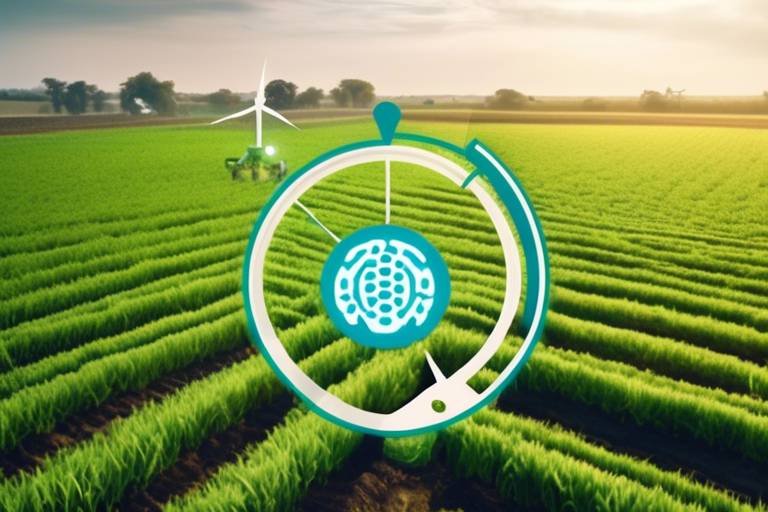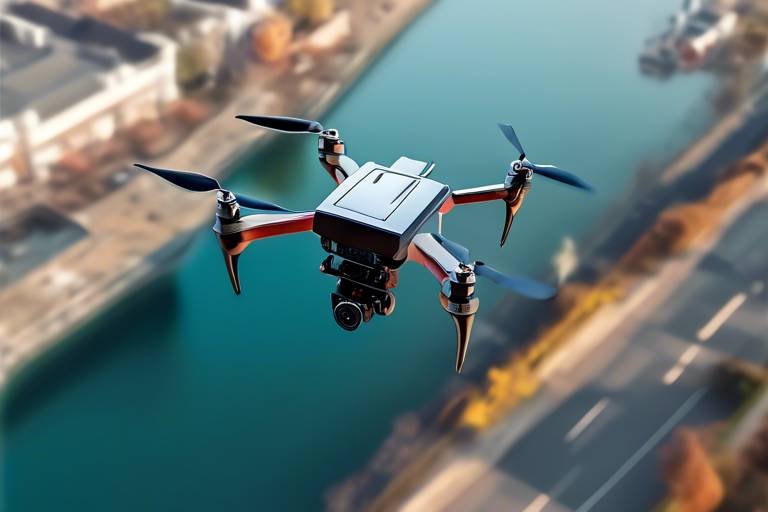Innovative AI Solutions in Agriculture: A Game Changer?
In recent years, the agricultural sector has witnessed a seismic shift, thanks to the advent of artificial intelligence (AI). This technology is not just a buzzword; it’s becoming a vital tool for farmers around the globe. Imagine a world where farmers can predict crop yields with pinpoint accuracy, monitor soil health in real-time, and automate labor-intensive tasks. Sounds like something out of a sci-fi movie, right? Well, it’s happening right now! AI is revolutionizing farming practices, enhancing productivity, sustainability, and efficiency. But how exactly is this transformation taking place? Let’s dive into the intricacies of AI in agriculture and explore its profound impact.
To grasp the full potential of AI in agriculture, it’s essential to understand what AI really is. Essentially, AI refers to the simulation of human intelligence in machines that are programmed to think and learn like humans. In the context of agriculture, this means using algorithms and data analysis to make informed decisions that can lead to better farming outcomes. For instance, AI can analyze vast amounts of data from various sources, such as weather forecasts, soil conditions, and crop health, to provide actionable insights. This integration of AI into agricultural practices is not just about making farming more efficient; it’s about empowering farmers to make smarter decisions that can lead to increased yields and reduced waste.
One of the most exciting applications of AI in agriculture is precision farming. This technique leverages advanced technologies like drones and IoT sensors to monitor crops and soil health. Imagine a drone flying over vast fields, collecting data on crop conditions and soil moisture levels. This real-time information allows farmers to optimize resource use—think water, fertilizers, and pesticides—leading to healthier crops and a more sustainable farming model. With precision farming, farmers can ensure that every drop of water and every ounce of fertilizer is used efficiently, reducing costs and environmental impact.
Data analytics is another game-changing aspect of AI in agriculture. By harnessing the power of data, farmers can predict crop yields, manage pests, and make informed decisions based on real-time insights. For instance, AI can analyze historical data and current conditions to forecast future yields accurately. This predictive capability allows farmers to plan better, allocate resources wisely, and ultimately, increase their profits. It's like having a crystal ball that provides insights into the future of their crops!
At the heart of data analytics in agriculture are machine learning algorithms. These algorithms learn from data patterns and improve their predictions over time. For example, they can analyze data from previous growing seasons to identify trends and anomalies, helping farmers make better decisions. The more data these algorithms process, the smarter they become, leading to enhanced farm management practices. It’s a continuous cycle of learning and improvement that benefits farmers immensely.
Remote sensing technologies powered by AI are also making waves in agriculture. These technologies provide valuable insights into crop health and environmental conditions. By using satellite imagery and aerial drones, farmers can monitor their fields from above, identifying areas that need attention before problems escalate. This proactive approach not only saves time but also ensures that crops receive the care they need, when they need it.
As we explore the role of AI in agriculture, we cannot overlook the increasing use of automation and robotics. From planting seeds to harvesting crops, robots equipped with AI are enhancing efficiency across the board. For example, autonomous tractors can plow fields and plant seeds with incredible accuracy, reducing the time and labor required for these tasks. This technology not only boosts productivity but also allows farmers to focus on more strategic aspects of their operations.
The benefits of implementing AI solutions in agriculture are numerous and significant. Farmers are experiencing increased productivity, reduced labor costs, and improved sustainability. By optimizing resource use, AI helps farmers grow more with less, which is crucial in a world facing food security challenges. Moreover, the integration of AI can lead to better crop management practices, ultimately resulting in healthier produce and higher profits.
AI also plays a pivotal role in promoting sustainable farming practices. By optimizing resource use, farmers can significantly reduce waste and minimize their environmental footprint. For instance, AI can help determine the exact amount of water and fertilizers needed for each crop, ensuring that nothing goes to waste. This level of precision not only benefits the environment but also enhances the overall sustainability of agricultural practices.
From an economic standpoint, the adoption of AI technologies in agriculture can lead to substantial cost savings and increased profitability for farmers. By streamlining operations and improving decision-making, farmers can reduce operational costs and maximize their yields. This economic boost is particularly important for small-scale farmers who may struggle to compete in today’s market.
Despite the many advantages, there are challenges associated with implementing AI solutions in agriculture. High costs, data privacy concerns, and the need for technological literacy among farmers are significant hurdles that must be addressed. For instance, while large agribusinesses may easily absorb the costs of AI technologies, small-scale farmers might find these expenses prohibitive. Understanding these challenges is crucial for developing strategies to facilitate the widespread adoption of AI in agriculture.
Financial challenges can be a significant barrier for small-scale farmers when it comes to adopting advanced AI technologies. Solutions to overcome these barriers might include government subsidies, cooperative purchasing models, or partnerships with tech companies to make these tools more accessible.
Another critical issue is data privacy and security. As AI systems collect sensitive information about farming practices and crop performance, it’s essential to ensure that this data is protected. Farmers must be educated about the importance of data privacy and the measures they can take to safeguard their information.
Looking ahead, the future of AI in agriculture is bright. Advancements in technology, such as the integration of AI with other emerging technologies like blockchain and biotechnology, will further enhance agricultural practices. This synergy can lead to more transparent supply chains and improved crop varieties, ultimately benefiting farmers and consumers alike.
As AI continues to evolve, its integration with other technologies will create new opportunities for farmers. For example, combining AI with blockchain can enhance traceability in food supply chains, ensuring that consumers know exactly where their food comes from. This level of transparency can build trust and improve market access for farmers.
Finally, it’s essential to consider global trends in AI adoption within agriculture. Different regions are leveraging these technologies to address their unique challenges. For instance, countries facing severe water scarcity may prioritize AI solutions that optimize irrigation, while those dealing with pest infestations may focus on AI-driven pest management strategies. Understanding these trends will be crucial for shaping the future of agriculture worldwide.
- What is AI in agriculture? AI in agriculture refers to the use of artificial intelligence technologies to improve farming practices, enhance productivity, and optimize resource use.
- How does precision farming work? Precision farming uses technologies like drones and IoT sensors to monitor crop health and soil conditions, allowing farmers to make data-driven decisions.
- What are the benefits of AI in agriculture? Benefits include increased productivity, reduced labor costs, improved sustainability, and enhanced decision-making capabilities.
- What challenges does AI face in agriculture? Challenges include high costs, data privacy concerns, and the need for technological literacy among farmers.
- What does the future hold for AI in agriculture? The future includes advancements in technology, integration with other technologies, and global trends in AI adoption tailored to regional challenges.

Understanding AI in Agriculture
Artificial Intelligence, commonly known as AI, is revolutionizing various sectors, and agriculture is no exception. At its core, AI refers to the simulation of human intelligence in machines that are programmed to think and learn like humans. This technology is being integrated into agriculture to enhance decision-making processes and improve operational efficiency. Imagine a world where farmers can predict weather patterns, monitor soil health, and manage crop yields with pinpoint accuracy—all thanks to AI. It's not just a dream; it's becoming a reality!
So, how exactly is AI being utilized in agriculture? One of the primary ways is through the use of machine learning algorithms. These algorithms analyze vast amounts of data collected from various sources, such as sensors and satellite imagery. By processing this data, farmers can gain insights into crop health, soil conditions, and even pest infestations. For instance, if a farmer notices a decline in crop yield, machine learning can help identify whether the issue is due to a lack of nutrients, pests, or adverse weather conditions.
Moreover, AI technologies are also being employed in precision agriculture. This technique involves using data-driven insights to optimize farming practices. Farmers can utilize drones equipped with AI to monitor crop health from above, ensuring that every inch of their fields is receiving the attention it needs. This not only saves time but also minimizes waste, as resources can be allocated more effectively. It's like having a bird's-eye view of the entire farm, allowing for more informed decisions.
Additionally, AI is enhancing operational efficiency through automation. Robots and automated machinery can perform tasks such as planting, watering, and harvesting with incredible precision. This reduces the physical labor required from farmers and can lead to significant cost savings in the long run. For example, consider a robotic harvester that can work day and night, tirelessly collecting crops while human workers rest. This not only increases productivity but also ensures that crops are harvested at the optimal time, maximizing quality and yield.
In summary, understanding AI in agriculture is about recognizing its potential to transform traditional farming practices into highly efficient, data-driven operations. As farmers embrace these technologies, they are not only improving their productivity but also paving the way for a more sustainable future. The integration of AI into agriculture is like planting a seed that will blossom into a more prosperous and environmentally-friendly farming landscape.
- What is AI in agriculture?
AI in agriculture refers to the use of artificial intelligence technologies, such as machine learning and data analytics, to enhance farming practices and decision-making processes. - How does precision agriculture work?
Precision agriculture utilizes AI-driven data insights to optimize resource use, monitor crop health, and improve overall farm management. - What are the benefits of using AI in farming?
Some benefits include increased productivity, reduced labor costs, better resource management, and enhanced sustainability practices. - What challenges do farmers face when adopting AI?
Challenges include high costs, data privacy concerns, and the need for technological literacy among farmers.

Precision Farming Techniques
In the ever-evolving world of agriculture, precision farming stands out as a beacon of innovation. This approach leverages cutting-edge technologies to optimize field-level management regarding crop farming. Imagine a farmer equipped with tools that provide real-time data about soil health, moisture levels, and crop conditions. This is not a scene from a sci-fi movie; it's the reality of modern farming, thanks to the integration of artificial intelligence (AI) and various advanced technologies.
At the heart of precision farming are technologies such as drones and Internet of Things (IoT) sensors that gather vast amounts of data. Drones, for instance, can fly over fields, capturing high-resolution images that reveal critical information about crop health. These aerial views allow farmers to identify issues like pest infestations or nutrient deficiencies before they become severe. Meanwhile, IoT sensors embedded in the soil monitor moisture levels and nutrient content, sending alerts to farmers when conditions are less than ideal.
But how does this all translate into practical benefits? By utilizing these technologies, farmers can:
- Reduce Water Usage: IoT sensors help in applying water only where and when it’s needed, leading to significant water conservation.
- Enhance Crop Yields: With precise data, farmers can make informed decisions that lead to healthier crops and improved yields.
- Minimize Chemical Use: Targeted application of fertilizers and pesticides reduces waste and environmental impact.
The data collected through these methods is processed using sophisticated algorithms to provide actionable insights. For example, farmers can predict the best time to plant or harvest crops based on weather patterns and soil conditions. This predictive capability is further enhanced by machine learning algorithms, which continuously learn from new data to improve accuracy over time.
Moreover, the integration of remote sensing technologies plays a pivotal role in precision farming. These technologies allow farmers to monitor their fields from a distance, providing insights into crop health and environmental conditions without the need for constant physical presence. The information gathered can be visualized in various formats, such as heat maps, which highlight areas requiring attention. This visual representation makes it easier for farmers to prioritize their efforts and allocate resources effectively.
In summary, precision farming techniques are revolutionizing the agricultural landscape. By embracing AI, drones, IoT sensors, and remote sensing technologies, farmers are not only enhancing their productivity but also paving the way for sustainable agricultural practices. The future of farming is bright, and it's all about making smarter, data-driven decisions that benefit both the farmer and the environment.
Q1: What is precision farming?
A1: Precision farming is an agricultural management concept that uses technology to monitor and manage field variability in crops. It aims to optimize inputs and maximize yields.
Q2: How do drones contribute to precision farming?
A2: Drones provide aerial imagery and data collection, helping farmers assess crop health, monitor irrigation, and manage pest control effectively.
Q3: What are IoT sensors, and how are they used in agriculture?
A3: IoT sensors are devices that collect real-time data from the field, such as soil moisture and temperature, allowing farmers to make informed decisions about irrigation and fertilization.
Q4: Can precision farming reduce environmental impact?
A4: Yes, by optimizing resource use, reducing chemical applications, and conserving water, precision farming practices contribute to more sustainable agricultural methods.

Data Analytics for Crop Management
In the ever-evolving world of agriculture, data analytics has emerged as a crucial tool for enhancing crop management. Imagine having a crystal ball that not only predicts the weather but also tells you how much water your crops need or when to apply fertilizers. That's the power of data analytics, and it's revolutionizing the way farmers operate. By leveraging vast amounts of data collected from various sources, farmers can make informed decisions that lead to better yields and healthier crops.
At the heart of this transformation is the ability to analyze data in real-time. Farmers can now utilize sensor technology and IoT devices to gather information about soil moisture levels, nutrient content, and even pest populations. This data is then processed using advanced analytics tools, allowing farmers to pinpoint exactly what their crops need at any given moment. For instance, if a farmer notices a sudden drop in soil moisture, they can quickly adjust their irrigation system to prevent crop stress.
Moreover, data analytics enables farmers to predict crop yields with a high degree of accuracy. By analyzing historical data alongside current conditions, farmers can forecast how much produce they can expect at harvest time. This predictive capability is invaluable for planning purposes, helping farmers to manage their resources more effectively. For example, if a farmer anticipates a bumper crop, they can prepare their storage facilities and plan for transportation logistics well in advance.
Another significant advantage of data analytics in crop management is its role in pest and disease management. By monitoring environmental conditions and crop health, farmers can identify potential threats before they escalate. This proactive approach allows for timely interventions, such as targeted pesticide applications, which can save both time and money. In fact, utilizing data analytics can reduce pesticide use by up to 30%, making farming not only more efficient but also more sustainable.
To illustrate the impact of data analytics on crop management, consider the following table that summarizes key benefits:
| Benefit | Description |
|---|---|
| Improved Yield Predictions | Accurate forecasting of crop yields based on real-time data analysis. |
| Pest Management | Early detection of pests and diseases, allowing for timely interventions. |
| Resource Optimization | Efficient use of water, fertilizers, and other inputs based on precise data. |
| Sustainability | Reduction in chemical usage and waste through informed decision-making. |
In conclusion, data analytics is not just a trend; it’s a game changer in crop management. As farmers continue to embrace these technologies, we can expect to see significant improvements in productivity and sustainability in the agricultural sector. The future of farming is not just about growing crops; it’s about growing knowledge and making smarter decisions that benefit both the farmer and the environment.
- What is data analytics in agriculture? Data analytics in agriculture refers to the process of collecting, analyzing, and interpreting data to improve farming practices and decision-making.
- How can data analytics help in pest management? By analyzing environmental data and crop health, farmers can identify pest threats early and apply targeted treatments, reducing the need for broad-spectrum pesticides.
- Is data analytics expensive for farmers? While there may be initial costs associated with implementing data analytics tools, the long-term benefits often outweigh these costs through increased efficiency and yield.
- Can small-scale farmers benefit from data analytics? Absolutely! Many data analytics tools are now accessible and affordable, allowing even small-scale farmers to leverage data for improved crop management.

Machine Learning Algorithms
When it comes to revolutionizing agriculture, are at the forefront. These powerful tools analyze vast amounts of data to identify patterns and make predictions, much like a seasoned farmer who has learned to read the signs of nature over the years. Imagine having a digital assistant that not only understands the weather but can also predict how it will affect your crops. This is what machine learning brings to the table.
At its core, machine learning involves training a computer system using historical data, allowing it to improve its predictions over time. In agriculture, this means that algorithms can learn from past crop yields, weather patterns, and soil conditions to provide insights that help farmers make informed decisions. For instance, a machine learning model can predict the best time to plant seeds based on data from previous seasons, maximizing the chances of a bountiful harvest.
Moreover, machine learning algorithms can be categorized into different types, each serving unique purposes in agriculture:
- Supervised Learning: This approach uses labeled data to train models. For example, farmers can input data on crop health and yield, and the algorithm learns to predict outcomes based on this information.
- Unsupervised Learning: Here, the algorithm identifies patterns in unlabeled data. This can help farmers discover hidden correlations in soil health or pest populations without prior knowledge.
- Reinforcement Learning: This method involves algorithms learning through trial and error, akin to how a farmer might adjust practices based on the success of previous crops. This can optimize irrigation schedules or pest management strategies.
One of the most exciting applications of machine learning in agriculture is in the area of predictive analytics. By analyzing data from various sources, including satellite imagery and IoT sensors, these algorithms can forecast crop yields with remarkable accuracy. This not only helps farmers plan their harvests but also aids in supply chain management, ensuring that food reaches consumers efficiently.
However, the implementation of machine learning algorithms in agriculture is not without its challenges. Farmers need access to quality data and technological infrastructure, which can be a barrier, especially for small-scale operations. Additionally, understanding how to interpret the insights generated by these algorithms requires a certain level of technological literacy, which varies among farmers.
In conclusion, machine learning algorithms are transforming the agricultural landscape, offering tools that enable farmers to make data-driven decisions. As these technologies continue to evolve, we can expect even greater advancements that will not only enhance productivity but also promote sustainability in farming practices.
- What are machine learning algorithms? Machine learning algorithms are systems that learn from data to make predictions or decisions without being explicitly programmed.
- How do these algorithms help farmers? They provide insights into crop management, predict yields, and optimize resource usage, ultimately improving efficiency and productivity.
- Are there challenges in implementing machine learning in agriculture? Yes, challenges include data quality, technological infrastructure, and the need for farmers to understand how to use these tools effectively.

Remote Sensing Technologies
Remote sensing technologies are revolutionizing the way farmers monitor and manage their crops. By utilizing advanced satellite imagery and aerial data collection methods, these technologies provide farmers with real-time insights into their fields. Imagine having the ability to see your entire farm from above, pinpointing areas that need attention without ever stepping foot on the ground. This is the power of remote sensing!
At its core, remote sensing involves collecting data about an area from a distance, often using satellites or drones equipped with specialized sensors. These sensors can capture a wide range of information, including soil moisture levels, crop health, and even pest infestations. The data gathered can be analyzed to create detailed maps and reports that help farmers make informed decisions about resource allocation and crop management.
One of the most significant advantages of remote sensing technologies is their ability to enhance precision farming. With the help of Geographic Information Systems (GIS) and Global Positioning Systems (GPS), farmers can overlay data from remote sensors onto maps of their fields. This allows for targeted interventions, such as applying fertilizers or pesticides only where they are needed, thereby reducing waste and environmental impact.
For example, consider the following applications of remote sensing:
- Crop Health Monitoring: By analyzing the color and reflectance of crops, farmers can assess plant health and detect early signs of disease.
- Soil Analysis: Remote sensors can evaluate soil moisture and nutrient levels, helping farmers optimize irrigation and fertilization practices.
- Pest Detection: Early detection of pest infestations can lead to timely interventions, minimizing crop damage and loss.
Moreover, remote sensing technologies are not just limited to monitoring crop health. They can also track weather patterns and environmental changes, providing farmers with valuable information to adapt their practices. For instance, understanding rainfall patterns can help farmers decide the best time to plant or harvest, ensuring they maximize their yields.
However, while remote sensing offers numerous benefits, it also comes with challenges. The initial investment in technology and training can be a barrier for many farmers, especially those operating on a smaller scale. Additionally, interpreting the data collected requires a certain level of technological literacy, which may not be readily available to all farmers. Nevertheless, as technology continues to evolve and become more accessible, the potential for remote sensing to transform agriculture remains immense.
In conclusion, remote sensing technologies are paving the way for a new era in agriculture. By providing farmers with precise, actionable data, these tools not only enhance productivity but also promote sustainable farming practices. As we look to the future, it is clear that remote sensing will play a crucial role in ensuring food security and environmental stewardship.
Q1: What is remote sensing in agriculture?
Remote sensing in agriculture refers to the use of satellite or aerial imagery to collect data about crop health, soil conditions, and environmental factors from a distance.
Q2: How does remote sensing improve farming practices?
It enables farmers to make data-driven decisions, optimize resource use, monitor crop health, and detect issues like pest infestations early on.
Q3: Are remote sensing technologies expensive?
While there can be significant initial costs for technology and training, many farmers find that the long-term benefits, including increased yields and reduced waste, outweigh these costs.
Q4: Can small-scale farmers benefit from remote sensing?
Yes, many remote sensing solutions are becoming more affordable and user-friendly, making them accessible to farmers of all sizes.

Automation and Robotics in Farming
The landscape of agriculture is undergoing a remarkable transformation, thanks to the advent of automation and robotics. Imagine walking through a vast field where machines are tirelessly working, planting seeds, watering crops, and even harvesting produce—all without breaking a sweat. This is not a scene from a futuristic movie; it is the reality of modern farming. As farmers grapple with labor shortages and the need for increased productivity, automation is emerging as a vital solution to these challenges.
One of the most exciting aspects of automation in agriculture is the use of robotic systems. These machines are designed to perform specific tasks with precision and efficiency. For instance, autonomous tractors can plow fields and plant seeds with minimal human intervention. Drones equipped with advanced sensors can monitor crop health from above, providing farmers with crucial data to make informed decisions. In essence, these machines are not just tools; they are becoming integral partners in the farming process.
The benefits of integrating robotics into farming practices are numerous. Firstly, they significantly enhance efficiency. A robotic harvester can work around the clock, completing tasks that would take human workers days or even weeks. This not only saves time but also reduces labor costs, allowing farmers to allocate their resources more effectively. Moreover, automation helps in minimizing human error, ensuring that tasks are performed consistently and accurately.
However, the journey towards fully automated farming is not without its hurdles. The initial investment in robotic technology can be substantial, particularly for small-scale farmers. Yet, as technology advances and costs decrease, the adoption of these systems is likely to become more feasible. Furthermore, there is a growing need for training and support to help farmers understand and effectively utilize these technologies.
To illustrate the impact of automation and robotics, consider the following table, which outlines some key applications and their benefits:
| Application | Description | Benefits |
|---|---|---|
| Autonomous Tractors | Self-driving tractors that can plow, plant, and harvest crops. | Increased efficiency and reduced labor costs. |
| Drones | Unmanned aerial vehicles used for crop monitoring and spraying. | Enhanced data collection and precise resource application. |
| Robotic Harvesters | Machines designed to pick fruits and vegetables. | Faster harvest times and reduced reliance on seasonal labor. |
In conclusion, automation and robotics are not just trends; they are reshaping the agricultural sector for the better. By embracing these technologies, farmers can enhance their productivity, improve sustainability, and ultimately ensure a more secure food supply for the growing global population. The future of farming is bright, and it is powered by innovation.
- What are the main benefits of automation in farming? Automation increases efficiency, reduces labor costs, and minimizes human error in agricultural tasks.
- How can small-scale farmers afford robotic technology? While the initial investment can be high, advancements in technology are making these systems more affordable, and there are often grants and financing options available.
- What types of tasks can robots perform in agriculture? Robots can perform a variety of tasks, including planting, watering, monitoring crop health, and harvesting.
- Are there any challenges associated with using robotics in farming? Yes, challenges include high initial costs, the need for technical training, and potential issues with data privacy and security.

Benefits of AI in Agriculture
The integration of artificial intelligence (AI) in agriculture is revolutionizing the way farmers operate, providing a myriad of benefits that enhance productivity and sustainability. Imagine a world where farmers can predict crop yields with pinpoint accuracy, manage pests before they become a problem, and optimize their resource use to ensure every drop of water counts. This is not just a dream—it's the reality that AI is making possible. By leveraging AI technologies, farmers can make informed decisions that lead to greater efficiency and profitability.
One of the most significant advantages of AI in agriculture is the potential for increased productivity. With AI-driven tools like predictive analytics, farmers can assess various factors affecting crop growth, such as weather patterns, soil conditions, and pest infestations. This data allows them to take proactive measures, ultimately leading to a higher yield. For instance, a study showed that farms utilizing AI technology could see yield increases of up to 30% in certain crops compared to traditional farming methods.
Another vital benefit is the reduction in labor costs. Traditional farming practices often require a substantial workforce, which can be a strain on resources, especially for small-scale farmers. AI-powered automation, such as robotic harvesters and planting drones, can significantly cut down the need for manual labor. This not only saves money but also allows farmers to allocate their workforce to more critical tasks, enhancing overall operational efficiency.
Furthermore, AI contributes to environmental sustainability. By optimizing resource use—such as water, fertilizers, and pesticides—farmers can reduce waste and minimize their ecological footprint. For example, AI systems can analyze soil health and moisture levels to determine the precise amount of irrigation needed, preventing overwatering and conserving precious water resources. This sustainable approach not only benefits the environment but also aligns with the growing consumer demand for eco-friendly farming practices.
To give you a clearer picture, here’s a table summarizing some of the key benefits of AI in agriculture:
| Benefit | Description |
|---|---|
| Increased Productivity | AI tools help predict crop yields and optimize farming practices, leading to higher outputs. |
| Reduced Labor Costs | Automation and robotics decrease the need for manual labor, saving costs and improving efficiency. |
| Environmental Sustainability | AI optimizes resource usage, reducing waste and promoting eco-friendly practices. |
| Data-Driven Decisions | Farmers can make informed choices based on real-time data analytics, enhancing management strategies. |
In summary, the benefits of AI in agriculture are profound and far-reaching. From improving crop yields and reducing labor costs to promoting sustainable practices, AI is paving the way for a new era in farming. As technology continues to evolve, we can only expect these advantages to grow, creating a more efficient and productive agricultural landscape.
- How does AI improve crop yields?
AI analyzes various data points, such as weather and soil conditions, to help farmers make informed decisions that lead to better crop management. - Are AI technologies expensive for farmers?
While initial investments can be high, the long-term savings on labor and increased productivity often outweigh the costs. - Can small-scale farmers benefit from AI?
Yes, many AI solutions are becoming more accessible and affordable, allowing small-scale farmers to leverage technology for better results. - What role does data privacy play in AI agriculture?
Data privacy is crucial as AI systems collect sensitive information. Farmers should ensure that their data is protected and used ethically.

Environmental Sustainability
In today’s world, where climate change and environmental degradation are pressing issues, the role of artificial intelligence (AI) in promoting within agriculture cannot be overstated. Farmers are increasingly turning to AI technologies to make their practices more sustainable, ensuring that they not only produce food efficiently but also protect the planet for future generations. By optimizing resource use, reducing waste, and enhancing crop resilience, AI is helping to create a more sustainable agricultural landscape.
One of the most significant ways AI contributes to sustainability is through its ability to analyze vast amounts of data. For example, AI-driven systems can monitor soil health, weather patterns, and crop conditions in real-time. This information allows farmers to make informed decisions about when to irrigate, fertilize, or apply pesticides. By using resources more judiciously, farmers can minimize their environmental footprint while maximizing productivity. Imagine a farmer who can pinpoint the exact moment to water their crops, reducing water waste significantly—this is the power of AI in action.
Moreover, AI technologies can help in reducing chemical usage in farming. Through precise monitoring and predictive analytics, farmers can apply fertilizers and pesticides only when necessary, leading to a decrease in harmful runoff that can pollute waterways. This not only benefits the environment but also results in healthier produce, which is a win-win for both consumers and farmers.
Another aspect of AI’s contribution to sustainability is its role in promoting biodiversity. By analyzing data on various plant species and their interactions with pests and diseases, AI can help farmers adopt practices that support a diverse ecosystem. This can include crop rotation strategies or the introduction of cover crops that enhance soil health and provide habitats for beneficial insects.
To further illustrate the impact of AI on environmental sustainability, consider the following table that summarizes key benefits:
| AI Application | Environmental Benefit |
|---|---|
| Precision Agriculture | Reduces resource waste and minimizes environmental impact |
| Data-Driven Pest Management | Decreases pesticide use, protecting non-target species |
| Soil Monitoring | Enhances soil health by optimizing nutrient application |
| Climate Prediction Models | Helps farmers adapt to changing climate conditions |
In conclusion, the integration of AI in agriculture is paving the way for a more sustainable future. As farmers embrace these technologies, they are not only improving their yields but also contributing to the health of our planet. The journey towards sustainability is complex, but with AI as a guiding force, we are moving in the right direction.
- How does AI reduce resource waste in agriculture?
AI analyzes data to optimize the use of water, fertilizers, and pesticides, ensuring they are used only when necessary. - Can AI help in combating climate change?
Yes, by promoting sustainable farming practices and reducing emissions associated with traditional farming methods. - What are the economic benefits of using AI in sustainable agriculture?
Farmers can achieve cost savings through optimized resource use, leading to increased profitability and reduced operational costs.

Economic Impact
The integration of artificial intelligence (AI) into agriculture is not just a technological advancement; it represents a seismic shift in the economic landscape of farming. Farmers are increasingly recognizing that AI can be a powerful ally in boosting profitability and efficiency. But how exactly does this transformation occur? Let’s dive into the economic implications of adopting AI technologies in agriculture.
First and foremost, AI facilitates cost savings across various farming operations. By optimizing resource usage—be it water, fertilizers, or pesticides—farmers can significantly reduce their input costs. For instance, AI-driven precision agriculture allows farmers to apply inputs only where needed, minimizing waste and maximizing yield. This targeted approach not only conserves resources but also translates into substantial savings over time.
Moreover, AI enhances productivity by enabling farmers to make data-driven decisions. With advanced analytics, farmers can predict crop yields more accurately, manage pests effectively, and even forecast market demands. This capability not only helps in planning but also ensures that farmers can respond swiftly to changing conditions, thus safeguarding their income. In fact, a study by the McKinsey Global Institute suggests that AI could increase agricultural productivity by up to 70% in some regions by 2030.
Another critical aspect is the reduction of labor costs. As AI technologies automate routine tasks—such as planting, watering, and harvesting—farmers can operate with fewer hands. This is particularly beneficial in regions facing labor shortages or where labor costs are rising. For example, robotic harvesters can work around the clock, increasing efficiency while allowing human workers to focus on more complex tasks that require critical thinking and creativity.
However, it’s essential to recognize that the economic impact of AI in agriculture is not uniform across all regions or types of farming. Small-scale farmers may face barriers to entry due to the high initial costs of AI technologies. To address this, various initiatives are being developed to provide financial support and training for these farmers, ensuring that the benefits of AI are accessible to all.
To illustrate the economic benefits more clearly, consider the following table that summarizes the potential financial impacts of adopting AI in agriculture:
| Area of Impact | Potential Benefits |
|---|---|
| Resource Optimization | Reduced input costs through targeted application of resources |
| Yield Prediction | Increased crop yields due to informed decision-making |
| Labor Efficiency | Lower labor costs and enhanced operational efficiency |
| Market Responsiveness | Better alignment with market demands, reducing surplus and waste |
In conclusion, the economic impact of AI in agriculture is profound and multifaceted. By enhancing productivity, reducing costs, and enabling smarter decision-making, AI is paving the way for a more sustainable and profitable agricultural sector. As we continue to explore the potential of AI, it’s crucial to ensure that all farmers, regardless of their size or location, can harness these technologies to improve their livelihoods and contribute to global food security.
- What are the main benefits of AI in agriculture? AI helps in optimizing resource use, increasing productivity, and reducing labor costs.
- How can small-scale farmers access AI technologies? Various initiatives and programs are being developed to provide financial support and training for small-scale farmers.
- Is AI technology expensive to implement in farming? While there are initial costs, the long-term savings and increased productivity often outweigh these expenses.
- What role does data privacy play in agricultural AI? Data privacy is crucial as AI systems collect sensitive information; ensuring secure data handling is essential.

Challenges and Limitations
While the integration of artificial intelligence (AI) in agriculture presents numerous benefits, it is essential to acknowledge the challenges and limitations that accompany this technological revolution. First and foremost, one of the most pressing issues is the high costs associated with adopting advanced AI technologies. For many small-scale farmers, the financial burden of investing in AI-driven tools, such as drones, IoT sensors, and sophisticated data analytics platforms, can be overwhelming. These costs can include not just the initial purchase but also ongoing maintenance and updates, which can strain already tight budgets.
Moreover, the data privacy and security concerns are paramount in today's digital age. As AI systems collect vast amounts of sensitive information—from soil health to crop yields—farmers must grapple with the implications of data breaches and unauthorized access. The anxiety surrounding who owns this data and how it can be used adds another layer of complexity to AI adoption. Farmers often worry that sharing their data could lead to competitive disadvantages or even exploitation by larger agribusinesses.
Additionally, there is a significant gap in technological literacy among farmers, which can hinder the effective use of AI tools. Many farmers may not have the necessary skills or knowledge to interpret data analytics or operate advanced machinery. This digital divide can lead to a situation where only those with access to education and training can fully harness the potential of AI, leaving others behind. Bridging this gap is crucial for equitable growth in the agricultural sector and ensuring that all farmers can benefit from technological advancements.
To illustrate these challenges, consider the following table that summarizes the key barriers to AI adoption in agriculture:
| Challenge | Description |
|---|---|
| High Costs | Initial investment and ongoing maintenance of AI technologies can be prohibitive for small-scale farmers. |
| Data Privacy and Security | Concerns about who owns the data and the potential for breaches can deter farmers from adopting AI. |
| Technological Literacy | A lack of knowledge and skills among farmers can limit the effective use of AI tools. |
In conclusion, while the promise of AI in agriculture is immense, these challenges must be addressed to ensure that all farmers can take full advantage of the technology. By providing financial support, enhancing data security measures, and improving educational resources, we can pave the way for a more inclusive and prosperous agricultural future.
- What are the main challenges of implementing AI in agriculture? The main challenges include high costs, data privacy concerns, and a lack of technological literacy among farmers.
- How can small-scale farmers overcome financial barriers to AI adoption? They can seek grants, subsidies, or cooperative purchasing to share the costs of technology.
- Why is data privacy a concern in agricultural AI? Farmers worry about the ownership and potential misuse of sensitive data collected by AI systems.
- What can be done to improve technological literacy among farmers? Training programs, workshops, and collaboration with tech companies can help enhance skills and knowledge.

Cost Barriers
When we dive into the world of artificial intelligence in agriculture, one of the most pressing concerns that crops up is the issue of . For many small-scale farmers, the idea of integrating advanced AI technologies can feel like a daunting mountain to climb. The initial investment required for AI tools—such as drones, sensors, and software—can be prohibitively expensive. This can lead to a significant gap between large agribusinesses that can easily absorb these costs and smaller farms that may struggle to keep up.
Moreover, the financial burden doesn't stop at purchasing the technology. Farmers also need to consider ongoing expenses such as maintenance, software updates, and training. For instance, a farmer investing in a state-of-the-art drone might also need to budget for repairs, battery replacements, and potentially hiring skilled personnel to operate and analyze the data collected. This can create a vicious cycle where the costs deter farmers from adopting the technology in the first place, leaving them at a competitive disadvantage.
To illustrate this point, let’s take a look at a simple table comparing the costs associated with traditional farming methods versus those employing advanced AI technologies:
| Cost Factor | Traditional Farming | AI-Enhanced Farming |
|---|---|---|
| Initial Investment | Low ($5,000 - $10,000) | High ($20,000 - $100,000) |
| Maintenance Costs | Moderate ($1,000/year) | High ($3,000/year) |
| Training Costs | Minimal | Significant ($2,000 - $5,000) |
As you can see, the financial implications can be quite stark. However, it's important to note that there are potential solutions to mitigate these cost barriers. For instance, governments and agricultural organizations can step in to provide subsidies or grants aimed at helping farmers transition to AI technologies. Additionally, collaborative farming initiatives can enable small farmers to pool resources and share the costs of technological investments, making it more feasible for everyone involved.
In conclusion, while the cost barriers associated with AI in agriculture are significant, they are not insurmountable. With the right support systems in place, farmers can harness the power of AI to not only improve their productivity but also to ensure a sustainable future for agriculture as a whole.
- What are the primary costs associated with AI in agriculture? The main costs include initial investments in technology, ongoing maintenance, and training for personnel.
- How can small-scale farmers afford AI technologies? Government subsidies, grants, and collaborative farming initiatives can help alleviate financial burdens.
- Is the investment in AI worth it for small farmers? While the initial costs can be high, the long-term benefits of increased efficiency and productivity can lead to greater profitability.

Data Privacy and Security
In today's digital age, where data is often referred to as the new oil, the agricultural sector is no exception. As farmers increasingly rely on artificial intelligence (AI) to optimize their operations, the question of becomes more critical than ever. AI systems collect vast amounts of data, including sensitive information about crop yields, soil conditions, and even the personal details of farm owners. This data, if not properly secured, can be vulnerable to breaches, misuse, or unauthorized access.
Farmers need to understand that while AI can significantly enhance operational efficiency, it also brings with it a host of privacy concerns. For instance, many AI applications utilize cloud computing to store and analyze data. This reliance on external servers can expose sensitive information to potential cyber threats. Moreover, the integration of Internet of Things (IoT) devices in agriculture, such as smart sensors and drones, raises additional security challenges. Each connected device is a potential entry point for cybercriminals.
To address these concerns, farmers must take proactive measures to safeguard their data. Here are some essential strategies that can help:
- Data Encryption: Implementing strong encryption protocols ensures that data is unreadable to unauthorized users, even if it is intercepted.
- Access Controls: Limiting access to sensitive data only to authorized personnel can significantly reduce the risk of data leaks.
- Regular Software Updates: Keeping software and systems updated helps protect against known vulnerabilities that hackers might exploit.
- Data Anonymization: By anonymizing data, farmers can share valuable insights without compromising personal or sensitive information.
It's also crucial for farmers to be aware of the legal aspects surrounding data privacy. Regulations like the General Data Protection Regulation (GDPR) in Europe impose strict guidelines on how personal data should be handled. Compliance with such regulations not only protects farmers but also builds trust with consumers who are increasingly concerned about how their data is used.
In conclusion, while the integration of AI in agriculture promises numerous benefits, it is essential to prioritize . By implementing robust security measures and staying informed about legal obligations, farmers can harness the power of AI without compromising their data integrity. After all, in a world where information is power, safeguarding that information is paramount.
- What are the main data privacy concerns in agriculture? Data privacy concerns include unauthorized access to sensitive information, cyber threats, and compliance with regulations.
- How can farmers protect their data? Farmers can protect their data through encryption, access controls, regular software updates, and data anonymization.
- Are there regulations governing data privacy in agriculture? Yes, regulations like GDPR impose strict guidelines on data handling, which farmers must comply with to protect their information.

The Future of AI in Agriculture
The future of artificial intelligence in agriculture is not just a passing trend; it's a revolution that's set to redefine how we grow our food. Imagine a world where farmers can predict weather patterns with pinpoint accuracy, optimize crop yields, and manage resources efficiently—all thanks to AI. The possibilities are as vast as an open field. As we look ahead, there are several exciting trends and advancements that suggest AI will play an increasingly central role in farming practices.
One of the most promising aspects of AI's future in agriculture is its potential for integration with other emerging technologies. For instance, when combined with blockchain technology, AI can enhance traceability in the food supply chain. This means consumers will have access to detailed information about the origin of their food, fostering greater trust and transparency. Additionally, the integration of AI with biotechnology could lead to the development of crops that are not only more resilient to climate change but also more nutritious.
Furthermore, as AI technologies become more affordable and accessible, we can expect a significant global adoption trend. Regions that have traditionally struggled with agricultural productivity will likely leverage AI to address their unique challenges. For example, in developing countries, AI-powered mobile applications can provide smallholder farmers with real-time data on weather, soil conditions, and pest management, empowering them to make informed decisions. This is not just about technology; it's about enhancing livelihoods and improving food security on a global scale.
As we venture into this future, it's essential to consider the role of data analytics in shaping agricultural practices. AI systems will continue to evolve, utilizing vast amounts of data collected from various sources, including IoT sensors and satellite imagery. This data will enable farmers to make precise decisions that can significantly enhance productivity. For instance, predictive analytics can help determine the optimal time for planting and harvesting, ensuring that crops are grown under the best possible conditions.
However, as we embrace these advancements, we must also address the challenges that come with them. Ensuring that farmers have the necessary technological literacy to utilize AI tools effectively will be crucial. Training programs and resources will need to be developed to help farmers adapt to these new technologies. Additionally, as more data is collected, concerns regarding data privacy will need to be addressed. Farmers must feel confident that their sensitive information is protected, and regulations will need to be established to safeguard their data.
In conclusion, the future of AI in agriculture holds immense potential. By integrating with other technologies, enhancing data analytics, and addressing challenges, AI can transform the agricultural landscape, making it more productive, sustainable, and resilient. As we stand on the brink of this exciting new era, one thing is clear: the seeds of innovation are being sown, and the harvest will be nothing short of extraordinary.
- What role will AI play in sustainable agriculture?
AI will optimize resource use, reduce waste, and promote environmentally friendly practices, leading to more sustainable farming. - How can small farmers benefit from AI technologies?
Small farmers can leverage AI tools for real-time insights, improving decision-making and increasing productivity without significant investment. - What are the barriers to adopting AI in agriculture?
Challenges include high costs, lack of technological literacy, and concerns over data privacy and security.

Integration with Other Technologies
As we venture into the future of agriculture, the integration of artificial intelligence (AI) with other cutting-edge technologies is paving the way for a new era in farming. Imagine a world where drones, blockchain, and biotechnology work hand-in-hand with AI to create a seamless agricultural ecosystem. This synergy not only enhances productivity but also addresses some of the most pressing challenges faced by farmers today.
To illustrate this, let's consider how blockchain technology complements AI in ensuring transparency and traceability in the food supply chain. By utilizing blockchain, farmers can securely record every step of their product’s journey from the field to the consumer. When combined with AI, this data can be analyzed to optimize supply chains, predict market demands, and even identify inefficiencies that can be addressed to reduce waste. For instance, if AI detects that a certain crop is in high demand, it can alert farmers to increase production accordingly, all while ensuring that the entire process is transparent and verifiable through blockchain.
Furthermore, the integration of AI with biotechnology can revolutionize crop management. AI algorithms can analyze genetic data and environmental conditions to suggest the best traits for crops, leading to the development of genetically modified organisms (GMOs) that are more resilient to pests and diseases. This not only boosts yields but also minimizes the need for chemical pesticides, promoting a healthier ecosystem. The combination of AI and biotechnology is akin to having a seasoned coach guiding a team of athletes, ensuring that every player is in the right position to win the game.
Moreover, the Internet of Things (IoT) plays a crucial role in this integration. IoT devices equipped with AI capabilities can collect real-time data from the fields, such as soil moisture levels, weather conditions, and crop health. This data can then be analyzed to provide farmers with actionable insights. For example, if AI detects that certain areas of a field are drier than others, it can recommend targeted irrigation strategies, ensuring that water resources are used efficiently. This is like having a personal assistant who not only gathers information but also provides tailored recommendations to optimize every aspect of your agricultural operations.
As we look forward, the collaboration between AI and these emerging technologies is set to transform the agricultural landscape. Farmers who embrace this integration will not only enhance their productivity but also contribute to a more sustainable and efficient food system. The future of agriculture is not just about planting seeds; it's about planting the seeds of innovation that will grow into a bountiful harvest for generations to come.
- How does AI improve crop management?
AI enhances crop management by analyzing data to predict yields, manage pests, and optimize resource use. - What role does blockchain play in agriculture?
Blockchain ensures transparency in the food supply chain, allowing for secure tracking of products from farm to table. - Can AI help in sustainable farming?
Yes, AI optimizes resource use and reduces waste, contributing to more sustainable farming practices. - What are the challenges of integrating AI in agriculture?
Challenges include high costs, data privacy concerns, and the need for technological literacy among farmers.

Global Adoption Trends
The world of agriculture is undergoing a seismic shift, thanks to the rapid adoption of artificial intelligence (AI) technologies. Farmers across the globe are starting to recognize the immense potential that AI holds for enhancing productivity and sustainability. From the fields of North America to the rice paddies of Asia, AI-driven solutions are being embraced, leading to a revolution in farming practices. But what does this global adoption look like, and how is it shaping the future of agriculture?
In regions like North America, farmers are leveraging AI to implement precision agriculture techniques. Drones equipped with AI capabilities are being used to monitor crop health, while predictive analytics help in making informed decisions about planting and harvesting. This has led to significant increases in crop yields and reductions in resource wastage. Meanwhile, in Europe, various government initiatives are promoting the use of AI in agriculture, focusing on sustainability and eco-friendly practices. This is crucial as Europe aims to meet its ambitious climate goals.
In contrast, developing countries are also beginning to adopt AI, albeit at a slower pace. Challenges such as limited access to technology and high costs can hinder progress. However, organizations are stepping in to provide support, offering affordable AI solutions that cater to the unique needs of small-scale farmers. For instance, mobile apps powered by AI are being developed to assist farmers in pest management and crop monitoring, making advanced technology more accessible.
According to a recent report, the global agricultural AI market is expected to reach $2.6 billion by 2025, growing at a compound annual growth rate (CAGR) of over 25%. This data indicates a strong trend towards the integration of AI in agricultural practices worldwide. The following table summarizes some key regions and their current adoption status:
| Region | Adoption Status | Key Technologies |
|---|---|---|
| North America | High | Drones, IoT Sensors, Predictive Analytics |
| Europe | Moderate | Data Analytics, Robotics, Smart Farming |
| Asia | Emerging | Mobile Apps, Remote Sensing |
| Africa | Low | Basic AI Tools, Educational Initiatives |
As we look toward the future, it's clear that the adoption of AI in agriculture is not just a trend; it’s a necessity. Farmers are increasingly facing the pressures of climate change, population growth, and resource scarcity. With the integration of AI technologies, they can better manage these challenges while maximizing their output. The collaboration between tech companies and agricultural stakeholders is essential in driving this change, ensuring that farmers have the tools they need to thrive in an increasingly complex environment.
In conclusion, the global adoption of AI in agriculture is a fascinating journey filled with opportunities and challenges. As technology continues to evolve, so too will the ways in which we cultivate our land and produce food. The key will be to ensure that these innovations are accessible to all farmers, regardless of their location or scale of operation. This way, we can ensure a sustainable future for agriculture worldwide.
- What is AI in agriculture? AI in agriculture refers to the use of artificial intelligence technologies to improve farming practices, enhance productivity, and promote sustainability.
- How does AI benefit farmers? AI helps farmers by providing data-driven insights, optimizing resource use, predicting crop yields, and automating various farming tasks.
- Are there challenges in adopting AI in agriculture? Yes, challenges include high costs, data privacy concerns, and the need for technological literacy among farmers.
- What is the future of AI in agriculture? The future looks promising, with advancements expected in technology integration, increased global adoption, and a focus on sustainable practices.
Frequently Asked Questions
- What is AI in agriculture?
AI in agriculture refers to the use of artificial intelligence technologies to enhance farming practices. This includes everything from precision farming, which uses data to optimize crop yields, to automation in planting and harvesting. By leveraging AI, farmers can make better decisions and improve their operational efficiency.
- How does precision farming work?
Precision farming utilizes AI technologies such as drones and IoT sensors to monitor crops and soil health. This allows farmers to collect real-time data and apply resources more efficiently, ensuring that each plant receives the right amount of water, nutrients, and care. It's like having a personal coach for your crops!
- What are the benefits of using AI in agriculture?
Implementing AI in agriculture offers numerous advantages, including increased productivity, reduced labor costs, and improved sustainability. By optimizing resource use and minimizing waste, AI not only helps farmers boost their yields but also contributes to a healthier environment.
- What challenges do farmers face when adopting AI technologies?
Some challenges include high initial costs, data privacy concerns, and the need for technological literacy among farmers. Small-scale farmers, in particular, may struggle with the financial investment required to implement these advanced systems.
- How can AI contribute to environmental sustainability in farming?
AI can optimize resource usage, reduce waste, and promote sustainable farming practices. By analyzing data on soil health and crop conditions, AI helps farmers make informed decisions that benefit both their farms and the environment, creating a win-win situation.
- What is the future of AI in agriculture?
The future of AI in agriculture looks promising, with advancements in technology and new applications on the horizon. We can expect greater integration of AI with other technologies, such as blockchain and biotechnology, which will further enhance agricultural practices and productivity.
- How is AI being integrated with other technologies in agriculture?
AI can be integrated with technologies like blockchain for better supply chain transparency and biotechnology for improved crop resilience. This synergy can lead to more efficient practices and innovative solutions to the challenges faced in agriculture today.
- Are there global trends in AI adoption in agriculture?
Yes, different regions around the world are adopting AI technologies in agriculture at varying rates. Some areas are leveraging these innovations to address specific challenges, such as climate change and food security, while others are focused on enhancing productivity and profitability.



















